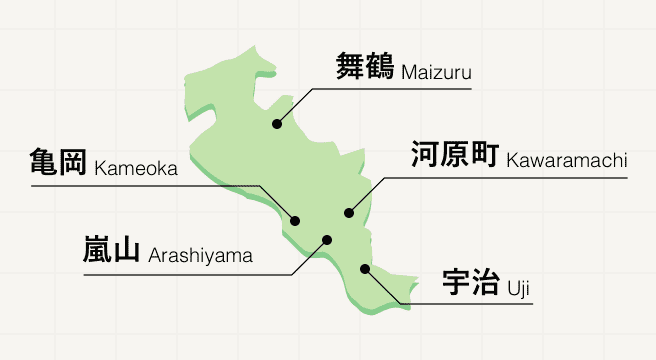Candy Store Spots in Around Kamigamo Area
Area
-
-
Kyoto
-
-
Kyoto
-
-
Around Kamigamo
-
- All areas
- Around Gion
- Around Kiyomizu-Dera Temple
- Around Okazaki
- Around Ginkaku-Ji Temple
- Ichijo-ji Temple / Shugakuin
- Around Fushimi Inari
- Around Kyoto Station
- City Center
- Around Kyoto Imperial Palace
- Around Nishijin
- Around Kamigamo
- Around Kinkaku-Ji Temple
- Uzumasa / Hanazono
- Arashiyama / Sagano / Takao
- Around Mt. Hiei
- Ohara / Kurama / Kifune
- Katsura / Nishiyama
- Yamashina / Daigo
- Around Fushimi
- Around Uji
- Joyo / Yawata
- Kyotanabe / Kizugawa
- Kameoka / Nantan
- Maizuru / Miyazu
-
Around Kamigamo

Category


-
- Aburimochi Kazariya
- Gourmet / Alcohol
- Kyoto Kyoutoshi Kita-ku Murasakinoimamiyachou 96
- This is a teahouse in front of the Imamiya Shrine east gate. Established over 400 years ago, the family art of confectionery has been passed on to the next daughter for each successive generation. The specialty is Aburi mochi. It is a rice cake dredged with soy flour and then grilled with a white miso sauce. At the storefront, one can watch the mochi being grilled, on bamboo skewers, igushi, which have been blessed by the Imamiya Shrine and are said to be effective in preventing disease and bad fortune. In addition to eating-in, take out orders for 3 or more can be ordered to go.
-
- Ichimonjiya Wasuke
- Gourmet / Alcohol
- Kyoto Kyoutoshi Kita-ku Murasakinoimamiyachou 69
- A venerable café and sweet shop founded over 1,000 years ago located on the approach to the east gate of Imamiya-jinja Shrine in Kyoto City’s Kita Ward. The shop’s renowned aburi mochi are an old-fashioned Japanese treated made by taking sticky, course pounded glutinous rice covered with kinako toasted soybean flour and broiling it over a charcoal fire on bamboo skewers. Ever-so-slightly sweet, the toasty aroma and delicious light brown miso sauce stimulates the appetite. Said to aid in healing from disease and even warding away disaster, these little treats have been popular with shrine visitors since ancient times. Patrons can take a break and enjoy a sweet from the couches and tatami seating in and outside the shop.
-
- Umezono Sabo
- Gourmet / Alcohol
- Kyoto Kyoutoshi Kita-ku Murasakinohigashifujinomorichou 11-1
- Umezono Sabo is a sister store to the old Japanese sweets cafe Umezono which opened in 2016, located along Kuramaguchi-dori Street about a seven-minute walk from Horikawa-Kuramaguchi bus stop. They make use of the Kyoto machiya (old townhouse) feel to create a relaxed retro atmosphere. At the second-floor teahouse, one can try Japanese black tea and green tea together with “Kazari-kan.” This is made by kneading red bean paste with vegetable gelatin and bracken and arranging like a Western sweet with fruits, nuts and fresh cream. This feast for the eyes is a new generation Japanese sweet, also available as a takeout and souvenir.
Kyoto Areas

Its wooden tea houses, shuffling geisha, and spiritual sights have seen Kyoto hailed as the heart of traditional Japan, a world apart from ultramodern Tokyo. Despite being the Japanese capital for over a century, Kyoto escaped destruction during World War II, leaving behind a fascinating history which can be felt at every turn, from the fully gold-plated Kinkakuji Temple down to traditional customs such as geisha performances and tea ceremonies, which are still practiced to this day.
Best of Kyoto
Search by Region
-
- Hokkaido / Tohoku
- Hokkaido
- Aomori
- Iwate
- Miyagi
- Akita
- Yamagata
- Fukushima
-
- Kanto
- Ibaraki
- Tochigi
- Gunma
- Saitama
- Chiba
- Tokyo
- Kanagawa
-
- Koshinetsu / Hokuriku
- Niigata
- Toyama
- Ishikawa
- Fukui
- Yamanashi
- Nagano
-
- Tokai
- Gifu
- Shizuoka
- Aichi
- Mie
-
- Kinki
- Shiga
- Kyoto
- Osaka
- Hyogo
- Nara
- Wakayama
-
- Chugoku
- Tottori
- Shimane
- Okayama
- Hiroshima
- Yamaguchi
-
- Shikoku
- Tokushima
- Kagawa
- Ehime
- Kochi
-
- Kyushu / Okinawa
- Fukuoka
- Saga
- Nagasaki
- Kumamoto
- Oita
- Miyazaki
- Kagoshima
- Okinawa














